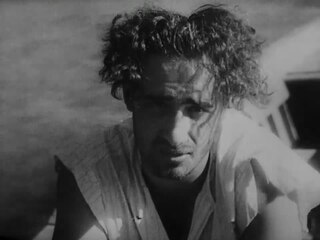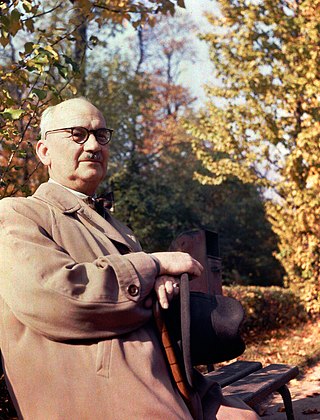
Animation is a filmmaking technique by which still images are manipulated to create moving images. In traditional animation, images are drawn or painted by hand on transparent celluloid sheets (cels) to be photographed and exhibited on film. Animation has been recognized as an artistic medium, specifically within the entertainment industry. Many animations are computer animations made with computer-generated imagery (CGI). Stop motion animation, in particular claymation, has continued to exist alongside these other forms.

William Norman McLaren, LL. D. was a Scottish Canadian animator, director and producer known for his work for the National Film Board of Canada (NFB). He was a pioneer in a number of areas of animation and filmmaking, including hand-drawn animation, drawn-on-film animation, visual music, abstract film, pixilation and graphical sound. McLaren was also an artist and printmaker, and explored his interest in dance in his films.

Drawn-on-film animation, also known as direct animation or animation without camera, is an animation technique where footage is produced by creating the images directly on film stock, as opposed to any other form of animation where the images or objects are photographed frame by frame with an animation camera.

Leonard Charles Huia Lye was a New Zealand artist known primarily for his experimental films and kinetic sculpture. His films are held in archives including the New Zealand Film Archive, British Film Institute, Museum of Modern Art in New York City, and the Pacific Film Archive at University of California, Berkeley. Lye's sculptures are found in the collections of the Whitney Museum of American Art, the Art Institute of Chicago, the Albright-Knox Art Gallery and the Berkeley Art Museum. Although he became a naturalized citizen of the United States in 1950, much of his work went to New Zealand after his death, where it is housed at the Govett-Brewster Art Gallery in New Plymouth. He is best remembered for his 1933 short film "experimental Animation 1933," better known as "The Peanut Vendor."
While the history of animation began much earlier, this article is concerned with the development of the medium after the emergence of celluloid film in 1888, as produced for theatrical screenings, television and (non-interactive) home video.
Oskar Wilhelm Fischinger was a German-American abstract animator, filmmaker, and painter, notable for creating abstract musical animation many decades before the appearance of computer graphics and music videos. He created special effects for Fritz Lang's 1929 Woman in the Moon, one of the first sci-fi rocket films, and influenced Disney's Fantasia. He made over 50 short films and painted around 800 canvases, many of which are in museums, galleries, and collections worldwide. Among his film works is Motion Painting No. 1 (1947), which is now listed on the National Film Registry of the U.S. Library of Congress.

Experimental film or avant-garde cinema is a mode of filmmaking that rigorously re-evaluates cinematic conventions and explores non-narrative forms or alternatives to traditional narratives or methods of working. Many experimental films, particularly early ones, relate to arts in other disciplines: painting, dance, literature and poetry, or arise from research and development of new technical resources.
The history of Russian animation is the visual art form produced by Russian animation makers. As most of Russia's production of animation for cinema and television were created during Soviet times, it may also be referred to some extent as the history of Soviet animation. It remains a nearly unexplored field in film theory and history outside Russia.

Walter Ruttmann was a German cinematographer and film director, an important German abstract experimental film maker, along with Hans Richter, Viking Eggeling and Oskar Fischinger. He is best known for directing the semi-documentary 'city symphony' silent film, with orchestral score by Edmund Meisel, in 1927, Berlin: Symphony of a Metropolis. His audio montage Wochenende (Weekend) (1930) is considered a major contribution in the development of audio plays.

Motion graphics are pieces of animation or digital footage that create the illusion of motion or rotation, and are usually combined with audio for use in multimedia projects. Motion graphics are usually displayed via electronic media technology, but may also be displayed via manual powered technology. The term distinguishes static graphics from those with a transforming appearance over time, without over-specifying the form. While any form of experimental or abstract animation can be called motion graphics, the term typically more explicitly refers to the commercial application of animation and effects to video, film, TV, and interactive applications.

Dufaycolor is an early British additive colour photographic film process, introduced for motion picture use in 1932 and for still photography in 1935. It was derived from Louis Dufay's Dioptichrome plates, a glass-based product for colour still photography, introduced in France in 1909. Both Dioptichrome and Dufaycolor worked on the same principles as the Autochrome process, but achieved their results using a layer of tiny colour filter elements arrayed in a regular geometric pattern, unlike Autochrome's random array of coloured starch grains. The manufacture of Dufaycolor film ended in the late 1950s.

The Legend of the Sky Kingdom is a 2003 animated feature film directed by Roger Hawkins. Produced in Harare, Zimbabwe, the film was the first full-length animated feature film to come out of Africa. It was based on a children's book of the same name by Phil Cunningham, who was also the film's producer.
Begone Dull Care is a 1949 visual music animated film directed by Norman McLaren and Evelyn Lambart for the National Film Board of Canada (NFB).
United Kingdom Animation began at the very origins of the art form in the late 19th century. British animation has been strengthened by an influx of émigrés to the UK; renowned animators such as Lotte Reiniger (Germany), John Halas (Hungary), George Dunning and Richard Williams (Canada), Terry Gilliam and Tim Burton have all worked in the UK at various stages of their careers. Notable full-length animated features to be produced in the UK include Animal Farm (1954), Yellow Submarine (1968), Watership Down (1978), and Wallace & Gromit: The Curse of the Were-Rabbit (2005).

A film – also called a movie, motion picture, moving picture, picture, photoplay or (slang) flick – is a work of visual art that simulates experiences and otherwise communicates ideas, stories, perceptions, feelings, beauty, or atmosphere through the use of moving images. These images are generally accompanied by sound and, more rarely, other sensory stimulations. The word "cinema", short for cinematography, is often used to refer to filmmaking and the film industry, and the art form that is the result of it.
Non-narrative film is an aesthetic of cinematic film that does not narrate, or relate "an event, whether real or imaginary". It is usually a form of art film or experimental film, not made for mass entertainment.
Kill or Be Killed is an 18 minute long, documentary-style film directed in 1942 by experimental New Zealand artist Len Lye during his time working for the British Government's Ministry of Information. The initial purpose of the film was to serve as a military training tool and a piece of post-war propaganda viewable by the general public, but since its release, both critics and filmmakers alike have hailed it as a “masterpiece of filmmaking,” claiming that the realistic cinematography is both pleasing in aesthetics and technicality for its time. The film is most notable for its use of subjective viewing.
Roger John Horrocks is a New Zealand writer, film-maker, educator and cultural activist.

Experimental animation is a form of animation in which motion pictures have their own rhythm and movement where it has no narration or a specific structure in animated films. It is considered to be subjective and non-linear that deals with philosophic and spiritual concerns that the artists and film-makers convey.
Jack Ellitt was a British filmmaker, composer and musician. He was born Avrom Yitzhak Elitski to an orthodox Jewish Lithuanian family in Manchester and raised in Sydney from the age of 3.











